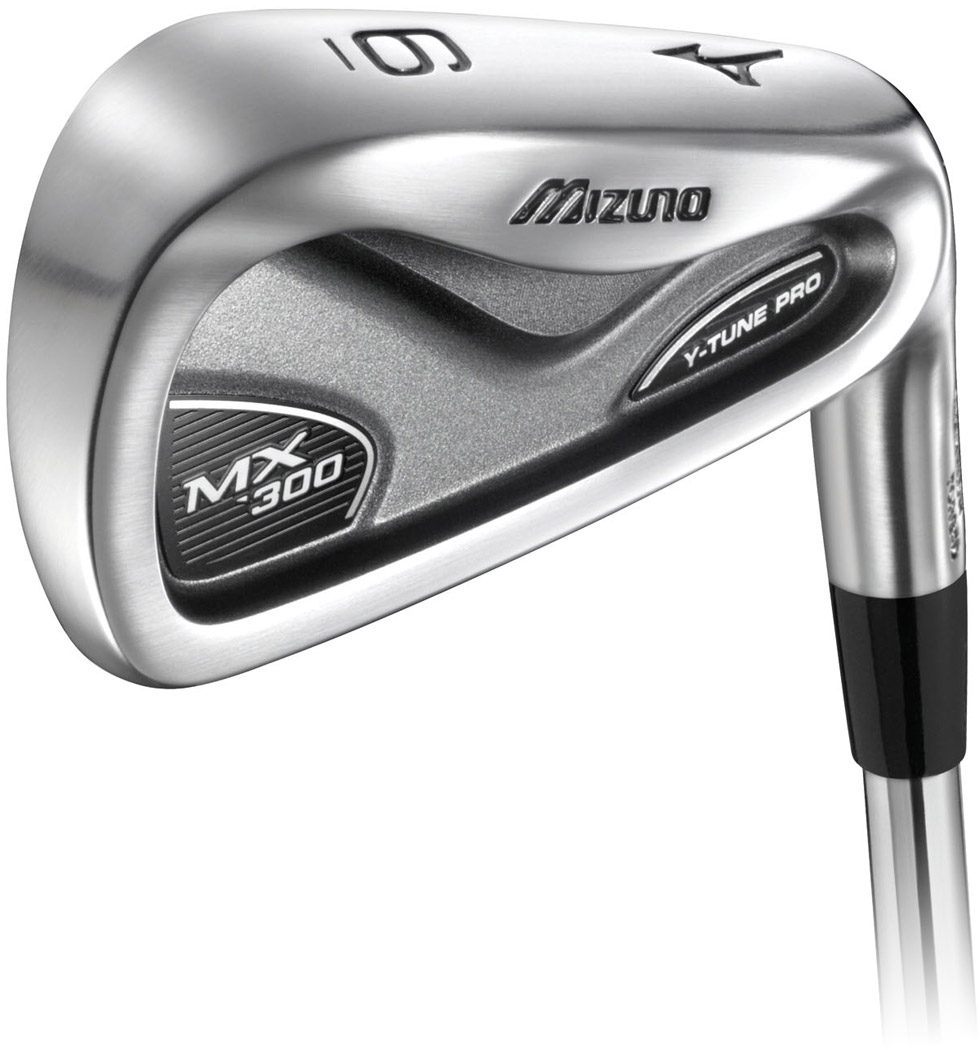 I’ll be honest with you, I feel like I really need to throw everything I believed about irons in the “game improvement” category out the window. Quickly. The Mizuno MX-300s changed my mind about what a game improvement iron should be and how a game improvement iron should feel. And this is coming from someone who thinks the constant Mizuno praise gets a little old sometimes.
I’ll be honest with you, I feel like I really need to throw everything I believed about irons in the “game improvement” category out the window. Quickly. The Mizuno MX-300s changed my mind about what a game improvement iron should be and how a game improvement iron should feel. And this is coming from someone who thinks the constant Mizuno praise gets a little old sometimes.
Don’t get me wrong, there is no doubt that Mizuno is one of the top iron makers on the market, and has been so for a while. Every time I tried a set, I walked away impressed with the looks, the feel, and the performance. It’s just that Mizuno has a somewhat rabid fan base, and though their love for the forged iron maker undeniably justified, I’m the kind of person that’s maybe best described as “anti-hype” and therefore, I tend to stay away from the things everyone hypes too much. I guess I like to be different. Still, when I was given the opportunity to review the newest irons in Mizuno’s MX series, I was more than happy to oblige. I knew that I was in for a treat, especially since I remembered thinking their intention to blur the line between player’s iron and GI iron was pretty interesting back in October, when I covered their release.Now that I’ve had a while to get acquainted with the MX-300 irons, I can honestly say that I had no idea that I’d be this impressed. Elated or euphoric might be the better words in this case. Before we get into my thoughts and opinions though, lets first take a look at what makes these new irons tick.
Design
Mizuno set out to create a club that fits somewhere between a players iron and a game improvement iron, and from that idea came the MX-300 line of irons. To give you a better idea of the concept behind the MX-300, think “a more forgiving MP iron.” Yes, the workability and sleek appearance is still there, but so is a larger sweet spot, and a nearly invisible cavity. The MX-300s are made from the Grain Flow Forged, 1025E “Pure Select” mild carbon steel, which plays a big part in that feel that Mizuno fans adore. In conjunction with the Grain Flow Forging process, Modal Analysis was used to further perfect that sweet, buttery soft feel and sound at impact.
They are in fact the successor to the MX-200 irons that were released in early 2009, and share some of the same design features. The Y-Tune Technology in the MX-200 has been updated in the new series and is now called Y-Tune Pro and is said to provide a much larger sweet spot, which further increases the forgiveness across the clubface. The Y-shaped channel in the cavity is visual evidence of the Y-Tune Pro Technology.
A milled pocket cavity can be found in the long and mid-irons, while the short irons make use of a solid power bar. By doing this, Mizuno was able to optimize the center of gravity depending on the type of shot each iron provides. The solid power bar gives more control in the scoring irons, while the milled pocket cavity allows for weight to be relocated low and deep to help achieve a higher ballflight with the long irons.
Esthetics
Though labeled as a game improvement iron, the MX-300 exudes the beauty that you might normally find in a blade. The thin top line is an indication that these irons don’t exactly fit squarely into that GI category, and thus are not very bulky or excessively thick. Looking at the cavity, the Y-Tune Pro is immediately identifiable by the “Y” shaped relief, as well as the “Y-Tune Pro” badging on the top hosel side of the cavity. Opposite that badge, on the top toe side of the cavity is the MX-300 badge. Longtime Mizuno fans will immediately notice a deviation to Mizuno’s traditional use of blue and yellow in favor of a more subtle grey and black combination in the badging. Though I never had a problem with the blue and yellow combination, I found the updated color combo to be very sharp and sleek.
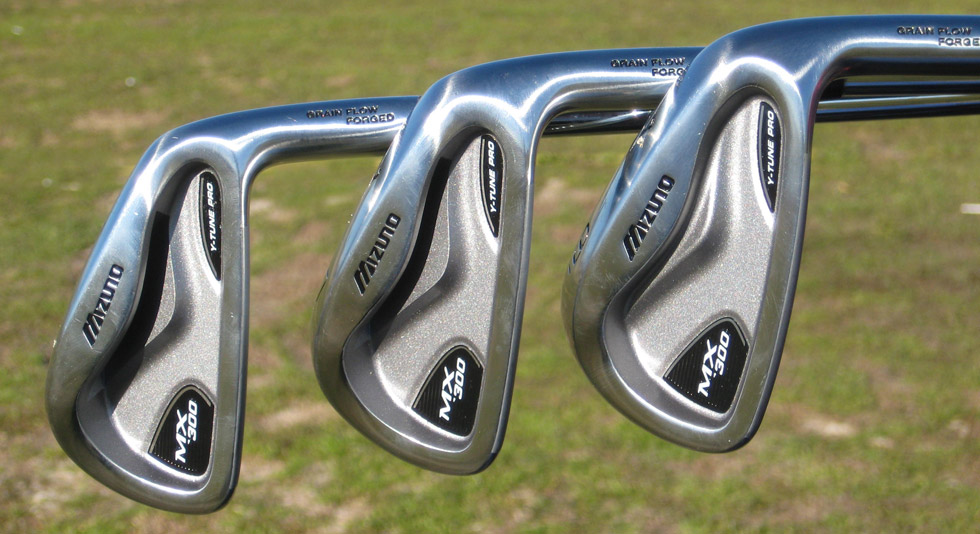
While it’s obvious that some of the design of the MX-300 is derived from the previous-generation MX-200, I found the MX-300 to be a good bit more esthetically pleasing, though most all of Mizuno’s irons are free of any distracting graphics or bulkiness. The MX-300s simply have a sharper, more elegant appearance than the older irons in the MX line.
Looking directly down at the cavity, the difference in the scoring irons and the long irons can be seen, as the short irons (8-PW) make use of the solid power bar, while the long irons (3-7) have an empty pocket cavity.
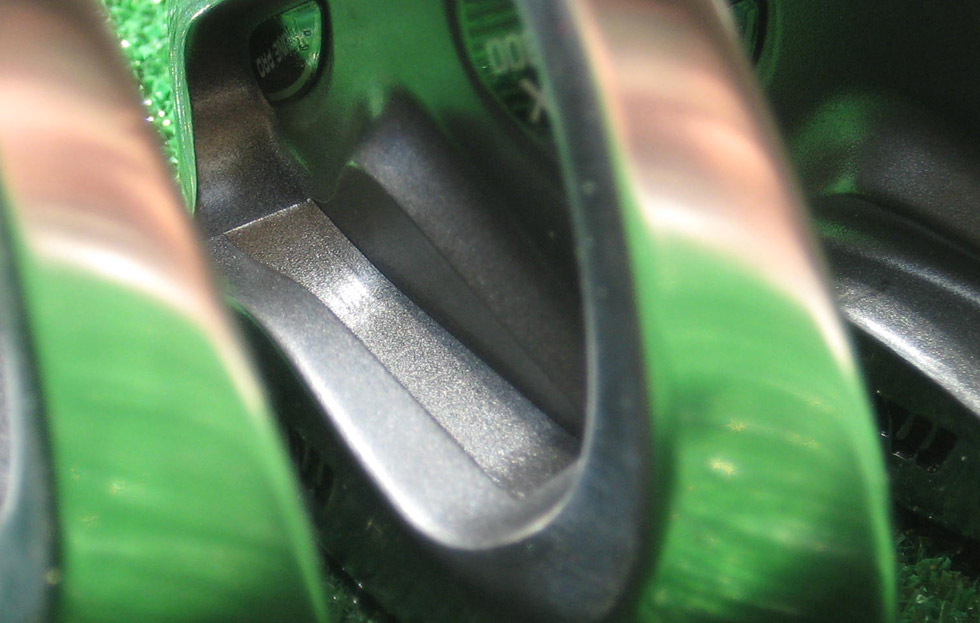
The cavity itself is not visible at address, which is undoubtedly a desired trait for the mass majority of players looking for a club in this category. Combine that with the thin top line and a minimal amount of offset, and the result is a club that appears very “player’s iron”-like at address, which is why the amount of forgiveness in these irons may come as such of a surprise. More on that later though.
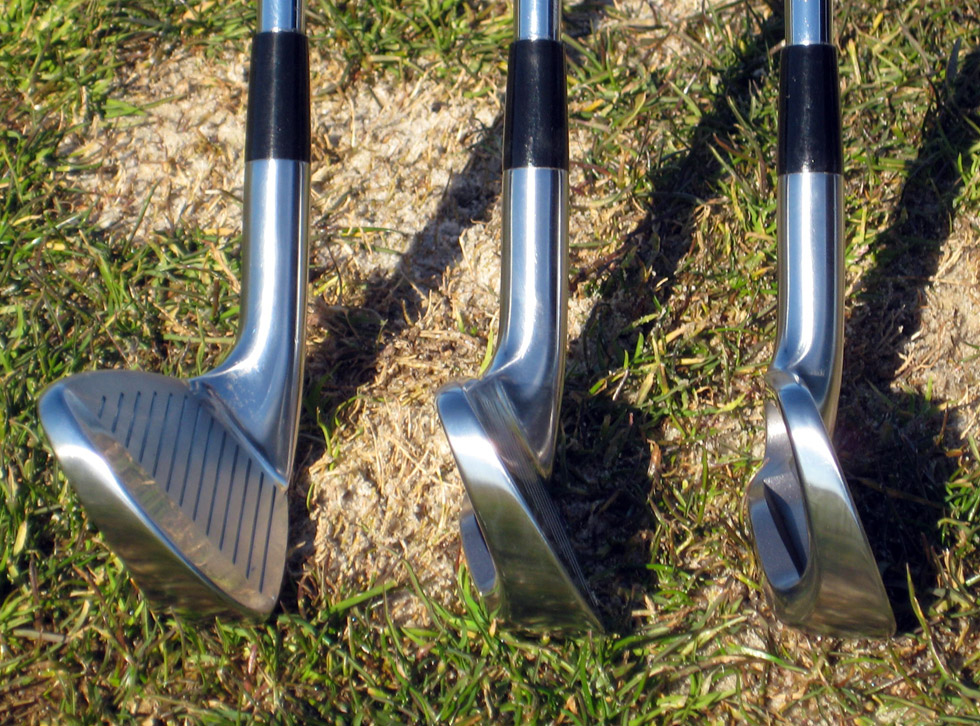
The hosel retains the familiar “Grain Flow Forged” stamping and leads down to the compact face which features modified U-grooves that are designed to conform to the new Conditions of Competition. The double nickel chrome plated finish gives the clubhead a very sleek, satiny look that I found very attractive.
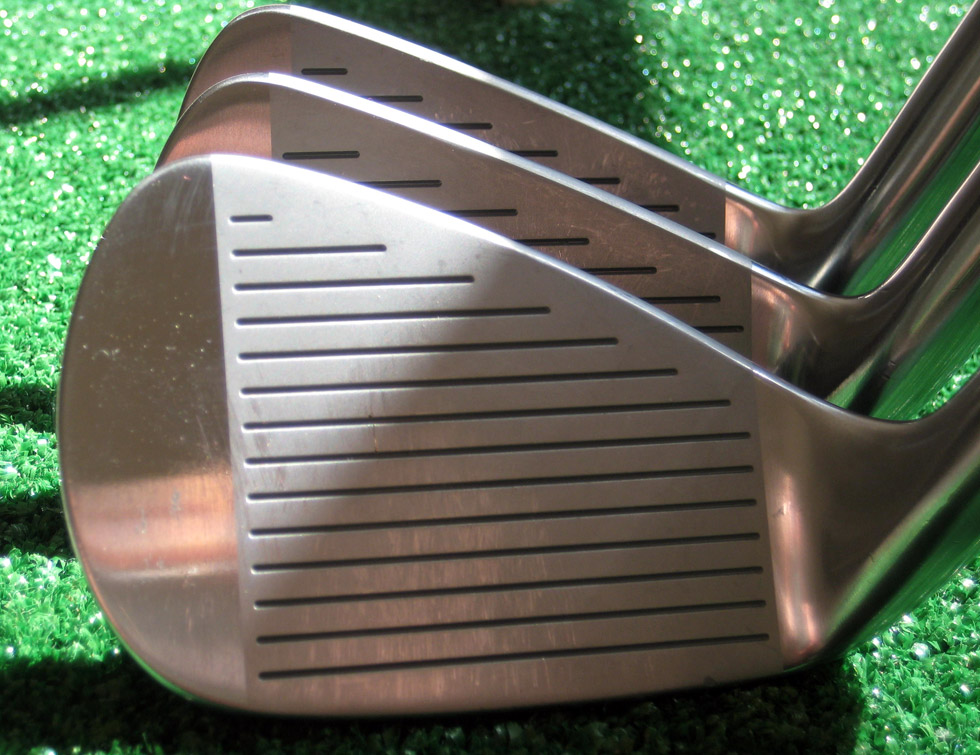
Performance
Upon unpacking the MX-300s, I was a little surprised, as I didn’t expect them to be as attractive as they were. They are much more elegant in person than they are in the pictures. At that point, I really didn’t know what to expect in terms of performance, because surely MX-level forgiveness couldn’t come in a package that looked almost MP-like at address. Once I took them out for their first test, I realized how wrong I was.
Set up was simple, as they are free of the large amount of offset that is present on some GI irons. Looking down at them, I almost swore I was looking down at my familiar Nike Victory Red Split Cavities. The topline was very similar, though not quite as thin as my VR forged blades.
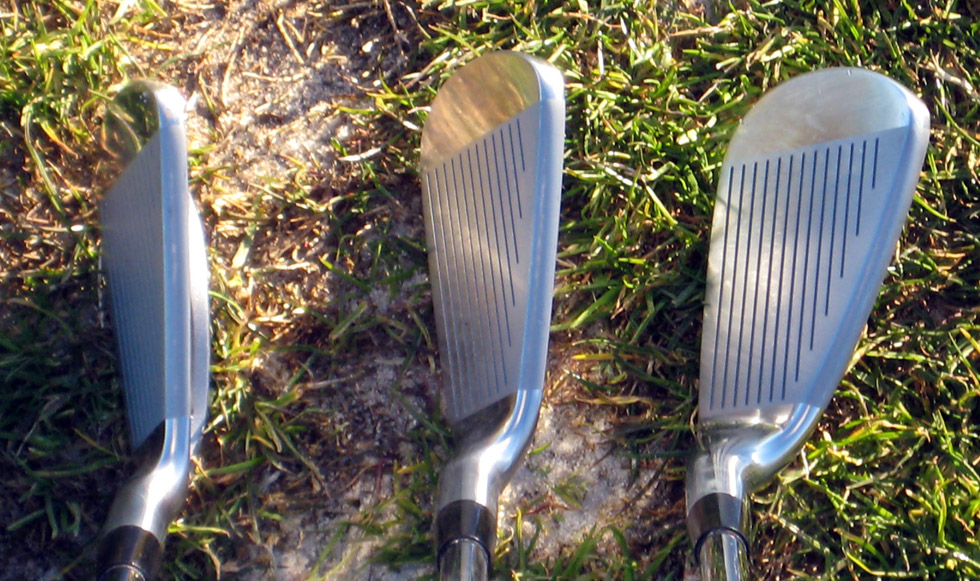
Though beating range balls hardly gives the same feel as contact with a quality ball, I had to start somewhere. My normal routine starts with a series of ½ and ¾ shots with a wedge or short iron. Even with rock-hard range balls, the feedback from the MX-300 gap wedge was accurate and soft (at least as soft as can be expected with range balls). As I progressed down through the mid-irons, I continued to be shocked by how great the feel was with these irons, even as I intentionally made contact off center. Of course if you get out to the extreme toe end, they let you know it. The thing about it was that they did give a slightly different feeling when I made contact off center, though it was still a nice soft feel. Where a lot of GI irons lose a lot of the ability to tell where on the face contact was made, these do not.
Normally, if you can tell you made contact outside of the sweet spot, you expect a loss of distance, but with these, that simply did not seem to be the case. Had I closed my eyes and hit these, and was allowed to see the results, I would swear I was hitting a SGI iron based on the results.
From the rough, they also performed exceptionally well, as they cut through the tall grass without getting stuck like some thicker, bulkier irons do sometimes. The dual cambered sole worked as advertised, as I never really had an issue getting them stuck when I’d come down extra hard and steep. In fact, they glided quickly through the turf, almost deceivingly so.
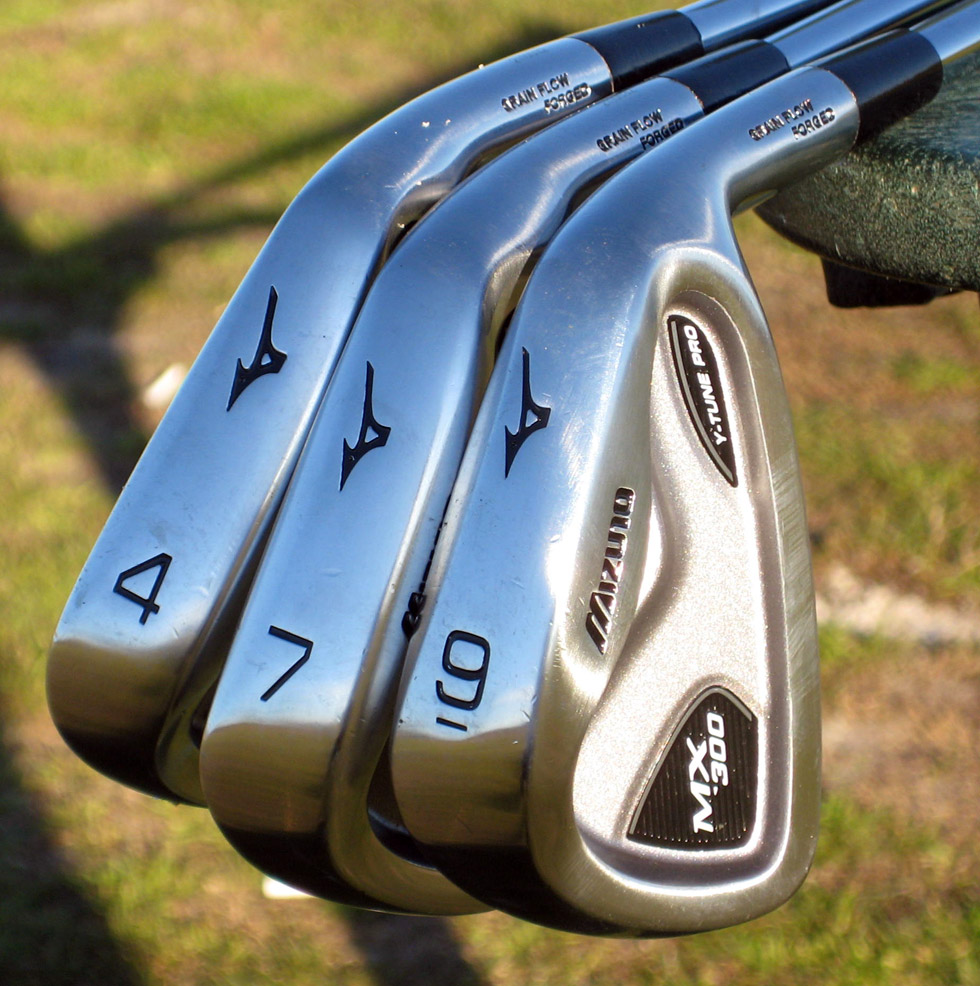
On my flush, solid shots, there was no noticeable difference in distance when compared side by side to my regular set, though the long irons are a single degree stronger. Where they shined was when I forced contact closer to the heel or the toe. As I said earlier, I can tell where contact was made, though it wasn’t the stinging penalty you may be used to. Instead, the feeling is still nice and soft, and the end result looks almost as good as a pured shot. There may have been a loss of three, maybe five yards at most.
Every iron in the set had a high, penetrating flight, and would land softly on the green without the worry of the ball rolling too far away from my target. If you like to work the ball, you should have little problem with the MX-300, as the extra level of forgiveness they offer isn’t too much to hinder their workability.
Specifications
Mizuno offers the MX-300s in a your standard array of lofts, ranging from a 3-iron, all the way up to a gap wedge, though the standard set runs 4-iron through 52° gap wedge. The stock shaft is the True Temper Dynalite Gold XP, in either the R300 or S300 flex profiles, and is a lighter, higher launching shaft than the Dynamic Gold. They come wrapped in Golf Pride M-21 58 round grips, which are somewhat similar to the popular Golf Pride Tour Velvet.
Being that I’m a little on the tall side, I usually require extra length and a more upright lie angle. Luckily, Mizuno Custom is there to take care of players such as myself. I also prefer the heavier weight of the Dynamic Gold versus that of the Dynalite Gold, and was happy to find that the Dynamic Gold is an option from the custom shop. On the subject of shafts, one notable difference between Mizuno’s irons and other manufacturers I’ve is that their standard length is a quarter-inch shorter, so if you may want to keep that in mind if you’re looking at getting a set tailored to your specs.
As mentioned, the iron set I tested came with the Dynamic Gold shafts instead of the standard Dynalite Gold XP. In addition to those shafts, others are available such as Royal Precision’s Rifle and Project X, and Nippon’s NS Pro 950. For a full list of custom shaft options, see here. Mizuno’s custom shop did a great job of setting me up with irons that meet my specs, and as an added bonus, they wrapped them with the Mizuno-branded New Decade Multicompound grips.
Standard Specs:
Club Loft Length Lie Bounce Offset ---- ---- ------ --- ------ ------ 3I 20° 38.75" 59.5° 1° 0.171 4I 23° 38.25" 60.0° 2° 0.161 5I 26° 37.75" 60.5° 2° 0.152 6I 29° 37.25" 61.0° 2° 0.142 7I 33° 36.75" 61.5° 3° 0.132 8I 37° 36.25" 62.0° 4° 0.122 9I 41° 35.75" 62.5° 5° 0.112 PW 45° 35.50" 63.0° 6° 0.102 GW 50° 35.25" 63.0° 7° 0.093
Conclusion
I truly believe Mizuno has a winner on their hands with the MX-300. I could see a 20 handicapper playing these just as easily as I could see a scratch golfer keeping them in the bag. They really are that versatile and really stay true to what Mizuno set out to do – create an iron that straddles the line between game improvement and players iron. I liked them so much that there is no doubt these will be in constant rotation in my bag for quite a while. Everything Mizuno fans love is here: the soft feel, the “click” on a solid shot, and the minimalist, aesthetic appearance.
I’d absolutely recommend these to anyone that can hit the ball in a fairly consistent manner. If you’re stuck in a spot where you cannot decide between players iron and game improvement iron, the Mizuno MX-300s may very well be exactly what you’re looking for. I also think these would be a great long iron option in a mixed set along with either the MP-58 or MP-68. Whether you opt for a full set or mixed, I fully believe these irons are an excellent choice that can give you the best a game improvement iron has to offer.

Aren’t these rebadged Mx 25 irons, which where great irons.
High praise indeed. I just bought a set of clubs so I wont need any for a while, but I try to buy a couple years behind, so I’ll keep these in mind when upgrade time comes back around.
FYI, some of the pictures don’t appear to be working, and I don’t think it’s just my browser. I tried to view just the picture itself, and received a TST “this page does not exist” message.
These are not replacing MX-200s according to Mizuno. They are simply another iteration of the MX line. Less offset than the MX-200s and both are still part of the line.
Mine just came in today, so stoked!! Nice review, just one correction, the gap wedge in this set is 50*
No pics visible?
Great review and very timely for me. I’m looking for new irons that are somewhat more forgiving than my current set (near blades). I’ve got the MX-300’s and the Bridgestone J38 Pocket Cavities on my short list to try. Any reviews of the Bridgestones? How do you think the Projext X shafts would compare to the Dymanic Gold’s in the MX-300s?
Can you compare the Titleist AP1 with the MX-300? — trying to decide between the two. I’m just getting back into golf in a serious way and am looking for clubs that I won’t have to change as I improve.
The spec table is right, the paragraph says 52* though
Great review-thanks !!!
As a 13 handicapper, these are on my short list. How do they compare to the Titleist AP2’s for forgiveness? thanks
It is really great that there are so many great clubs out there. One thing that is not so great is that so many game improvement improvement clubs are fugly. These, however, are aesthetically pleasing. I eventually decided on Titleist AP1s, but I was close to putting these in my bag. Nice review!
I’m dying. I bought the Mx-200’s last year and though I like them, these 300’s are even more up my alley. Mizuno’s timing doesn’t fit mine. Dang it. Hate to have to go through the pain (and money) of making another change. But I just might.
Great write up. I’m just starting the process of upgrading my irons after about a decade with Wilson Staff RM Forged in the bag. Thinking I’d like a blend of players club and GI, and I’ve always coveted Mizunos. Such a sweet look, always look so playable.
How did you find these in terms of workability? I never find myself playing a straight shot, always looking to move it one way or the other.
Would love to get my hands on a set up these. I didn’t catch the MSRP but I’m guessing it’s pretty pricey. Is this batch headed to your bag, to ebay, or back to Mizuno? :-p
Ron,
I work the ball a fair amount, though I go straight much more often. Either way, I had no issues working the ball when the situation presented itself. In terms of workability, I’d say these might lean slightly more towards players iron than GI iron in that category, which is weird because they ended up being much more forgiving than I thought they would be.
MSRP is $900, though street price is somewhere around $800 I believe.
And to answer your last question, see the 2nd to last paragraph 🙂 “I liked them so much that there is no doubt these will be in constant rotation in my bag for quite a while. ” And that is me being completely honest, as every time I’ve played in the last couple months, I struggle deciding between these and my Nike VRs. I think I’ll be holding on to the MX-300s for quite a while. 🙂
Mike,
Definitely keep watching TST, as I’m working on a review of the new AP1’s, and it should be up pretty soon.
Since this clubs have the U grooves, not sure if I would go with this set nor any other new ones since all have the same grooves. As a weekend golfer I’ll definetily stick to the old clubs with the sqare grooves. Not only they are much much cheaper, if not that I’ll be able to have the ball hold on to the greens while playing from the rough. I think it is stupid for the companies to be releasing all this clubs with the new gooves when we are not forced to play with them for the next 14 years. Absolutely stupid from my point of view.
how do you compare the mizuno mx-300 to the taylormade r9 irons? i can’t decide which set to go with.
Very good review and accurate. The most important accuracy is that the 300’s do not fit neatly into any category and represent what I think will be a new trend for irons, something I would call “performance clubs.” Kind of like a race car with an automatic clutch, far easier to drive but not sacrificing on power and performance. Having owned 4 different sets of Mizuno irons, including the MP30, MP33, MP57 and MX23’s I guess I am one of those “rabid” fans. I am most excited about the 300’s. I bought mine with the standard Gold XP shafts which were okay, but I chucked them and put project X 6.0’s in and boy did these clubs come to life. Easy to hit and just as workable as the MP33’s which I think might be one of the best irons ever made. The 300s are not as pretty as the 33s but the shots are just as pretty. Very accurate review and like I said not a “game improver” so much as a “Performance Improvement” iron. BTW I peeled off the plastic labeling on the irons and it made them look exceeding clean and much more blade-like. The labels didn’t bother me, but without them they look more like classic irons to me.
I bought a set of these last fall and they are the best I’ve played with. The feel is sweet and as the review states you can still feel when you are hitting off the toe, which I’m prone to do.
Bought mine with standard length, only regret is I didn’t have them made with an extra 1/2 inch. Otherwise perfect. Added the Mx700 17* hybrid to cover for the missing 2 and 3 iron on the 4-gw set.
Went through the fitting process with Mizuno yesterday and found the shaft optimizer extremely useful. Jerome from Mizuno Canada did a great job and recommended the MX300 (I’m a low 20 hdcp). Do you know Justin how much forgiveness I would give up by going MP52 instead? I prefer a more lofted PW (47 for the MP52) because I carry 52/58 wedges, and just like the looks of the MPs. Or should I play it smart and go with Mizuno’s recommendation? Thanks for any insights.
That’s a tough one to answer because it’s been nearly a year since I hit the MP-52’s, but I definitely understand your reasoning behind wanting to keep your loft gaps pretty consistent. It’s kinda hard to quantify forgiveness between the two as well. Honestly though, I gotta recommend the MX-300s. The MPs are great looking, no doubt, but looks aren’t all that counts, ya know what I mean? Besides, the MX-300s arent bad looking at all.
The ideal solution would be a mixed set of MX-300s and MP-52, but judging from the lofts on both sets, they’re not really going to blend very well. With that said, IMO, it’s always best to err in favor of forgiveness, and in this case go with the MX-300. I’d say stick with what they recommended.
If you’re pretty set on keeping your 52° and 58°, you could possibly look at getting either the PW or GW custom bended in order to get the lofts more to your liking. If you end up going that way, just remember that the bounce will change as well.
Edit: Sorry, almost forgot, if you’re looking for a more numerical-type of comparison as far as forgiveness goes, maybe check out the Maltby Playability Factor ratings at http://www.ralphmaltby.com/fitting. The MX-300 is in the 2010 guide and the MP-52 is in the 2009 guide. Hope that helps!
Thanks for your detailed reply Justin. I came to the same conclusion and ended up ordering the MX300s before your response came across. The view of the longer irons at address just inspires more confidence in the MX300s than in the MP-52s. I wasn’t married to my wedges so I ordered 4 through gap in the MX300s and then 54* and 58* in the MP-T10 wedges. Thanks again.
Great write up. I am a 9 and currently play the TaylorMade RAC TP Forged Irons. I love these irons, but I am looking to get a little more distance and forgiveness as I am getting a little older. I believe these could be a great replacement. Any thoughts?
Perhaps I should start by saying I have been playing with Ping irons for the last 25 years! So, I am not one of those “rabid” fans. I have bought the clubs 4 months ago and struggled at first to hit it sweetly (I also changed to a different lie-angle after a fitting session – perhaps one of the reasons).
Now however, I can report that your review is 100% spot-on! I am enjoying every shot and even golf partners are making comments about the great sound and consistent ball flight.
I was concerned that I could struggle to hit a semi-blade for the first time in my life and also in light of the fact that I getting older.
No regrets – I am very happy with the choice I made.
After taking up playing again seriously last year and doing terrifically well with a set of Hogan Gi’s I felt really confident I could progress and plunged for the new AP2’s in November. I hit them reasonably well(or so I thought) over winter at the range but didnt play much winter golf as the weather has been appallingly bad in the Uk-yes even bad for the UK!
Started playing again properly about 5 or 6 weeks ago and have been thoroughly depressed as I’ve barely hit a pure iron shot….Couldnt work out why….
Began to think I had bitten off more than I could chew with the AP2’s. Reluctant to admit it though after spending such a lot!
Anyway hit the MX300’s today…. OH MY GOD! It was like a huge weight lifted from my shoulders. I hit a dozen or so AP2 6 irons to a flag at 165 yards. Didnt land it once. A few ran up and on but other than that not good.
The Mx300 6 iron? The first one straight out of the middle landed at the back flag 175 yards and rolled about 4 feet. Second one? Flew the green so Im guessing 180 or so… A dozen balls later and I hadnt missed the green apart form a couple that went long. The worst landing at about 160 on the front edge. Trajectory was incredible. Clearly the club really helps you to get it up but it wasnt ballooning or it wouldnt be going 180!
The lesson? Dont try and be clever and run before you can walk. If I carried on with the ap2s this year I think Id struggle to retain my handicap never mind bring it down. Mx300’s will help bring it down, no question.
AP2 is a terrific club but it is a tour players club with a touch of forgiveness
not
a forgiving club with some playability like the mx300.
To be honest I think with so much help on offer from clubs like this unless you are a seriously low h’cap why bother with the extra pressure of absolutley having to pure it every time with a blade?
Mizuno really have come up with something special here guys. Fitting on Thursday..cant wait!(dont tell the wife!)
Love this site never posted a comment. Really have to make a comment on these irons. Been playing Wilson ci7 for the past 2 years and decided to make a change. The Wilson’s are extremely long for me but really never found a groove in terms of my consistancy. Always loved the length and hitting them made me feel good but I just never felt these were the right clubs for me. Also was getting over an achilees tendon rupture and after rehab these clubs just felt too heavy for me. Bought the MX-300 and what a difference in my life. I feel that these clubs encourage me to “swing” and not to hit. It’s hard to explain but with my Nippon NS Pro – 950, stiff flex it just feels right. For some reason these clubs encourage me to be easy in my tempo. I’ve lost some distance compared to my old ci7 (maybe 5 yards in my 6 iron) but im having less dispersion as well as way more consistancy. I’m a 20 handicap scoring 99-102 range usually. 2nd day out with these scored 96. Never had this feeling with a set of clubs and the review was spot on. This review is one of the first resources I used to research these clubs. I’m in love and have never had that feeling with a set of clubs before. Bravo!
I bought the MX300 with the S flex Dynalite Gold XP shaft after hitting Taylormade R9; Callaway Diablo Edge forged & cast; Titleist AP1, AP2 and CB; Cobra S2; and Nike VR at a local pro shop “demo days”. I hit the MX300 the best, with amazing feel and distance. After the Mizuno optimizations the clubs were far longer and straighter than anything I hit and my old clubs (2000 Clevleand TA7 in steel). The optimization is just incredible. I hit 9 different shaft/head combos and each felt and behaved so different it was mind boggling. On-center hits are soft, long and very straight. Off-center are still straighter than most game imporvement irons but and obvious harsh feel telling you that you didn’t hit it right. I’ve now played 3 times with this set and have dropped 3 strokes. Should be more, but I’m just getting to the point where I have convinced myself to align for how straight I hit these. No more compensating for fading my long irons to a draw to the lower irons and wedges – just take dead aim with everything! If I need a slight cut, I just move my hands neutral and take the same set up. Otherwise, dead aim at the flag stick. Amazing.
Addressing the questions on how these compare to AP1 or Taylormade, all I can say is I hit them better. I’ve always been in favor of getting professionally fit and buying whatever you hit the best at that point in your game. My only caveat is I love the feel of forged over cast. It’s a far softer and more solid feel – if you game is at that point.
Concur with Chili Guy that the MX300s are a trend-setter or game-changer; whatever you wanna call them. They feel and hit far different than your average game improvement set and provide far more forgiveness than your average players iron. Call ’em game assistance if you like. You can work these but the forgiveness is there when you need it.
Hi,
according to my local pro shop and Mizuno web site there is no GW available in mx-300. Are you sure you have tested an mx-300 GW?
Tnx
Fred
I don’t know about the Mizuno Web site or the local pro who says there is no gap wedge. When I ordered my set, I went 4 through GW, 2 degrees flat, one degree strong and that’s how they came.
Hi Fred,
Yes, the standard set definitely comes with a gap wedge. At the bottom of the following link, you will see the gap wedge listed last (under specs).
http://www.mizunousa.com/equipment.nsf/1/10glf1-irons-mx/210487?opendocument&div=golf&cat=10glf1-irons-mx
Gap wedge isnt being marketed in the Uk Fred…
Had been playing shovel-like, used, 6-8 y.o. Taylormade HT Rac irons for a few years (starting golf 3 years ago at age 37) and was struggling at times, no real feel of what was going on ‘down there’ 🙂 , and the used irons definitely had the wrong shaft weight, flex and clubhead weight combo for my quick backswing-to-downswing transition. would cause me to break down my left elbow on occasion, fade it to much, etc…
It’s likely that I would have found any custom fit 2009/2010 GI club much better since I think my biggest misfit was the used shafts, but I went for the MX-300 with the idea it would help me figure out how to dial in better contact, despite being somewhat intimidated by the mid/low-handicap billing as I’m a 21 (mostly held back by misses off the tee, however). After custom fitting, the guy indicated that my misses were mainly off the heel, so a more forgiving MX-200 would do nothing for me (it helps more for toe misses, you can clearly see that by how the cavity weight is distributed). He actually gave a mini-lesson to back away a bit, and I began hitting every test shot in the sweet spot.
Well anyway, the custom fitted set came in today, with the stiff-flex Nippon 950 98gram (a lighter shaft), and man… I was blistering the 8-iron 150 yards. After about 10 of these shots in a row, I wanted to walk up and down the range and advertise the clubs to everybody! Nice medium. penetrating flight, sometimes I’d deloft a bit, and draw it 165 with the 8-iron…jebus… I moved to the 6-iron and while I din’t catch it flush everytime, my flushes felt incredible and were about 175. (I’m 6′, very lean/strong, and can really whip the club through…the quick transition creates more lag too…not super-great for my back however. Not sure of swing speed, but it’s up there…) Much better for my quick transition, and has already helped me slow it down a bit. Of course, now I’m gonna have to refigure all my distances!
Amazing feel; I never knew what that actually ‘felt like’, now I do! Again, this is not all do the club, it’s a better shaft for me, etc.. But they are truly sweet clubs.
As for the Nippon shaft, I do sense a faster swing with a lighter shaft can reduce some control-feel, but shit, I’ll take it for now (if I get way more consistent with irons in general, I can always put in a heavier shaft!)
I was playing the Ping I-3 Blade irons for about five years and heard from several people (including my golfing buddy) that the MX-200 were amazing, more feel and longer distance. So, I went to a local fitting shop and got tested and fitted, compared against the Titleist AP1/AP2 and TaylorMade Burner irons and the Mizuno performed better for me.
So, I ended up buying the recommended Mizuno MX300s…However, after getting these clubs I have the same distance and less feel than my Ping I-3 Blades…maybe it’s the lighter Nippon shafts…but I had more feel with my Pings. Also, these clubs nick easily and because they are chrome plated it is more noticeable and will rust.
You can see pics and more info about my MX300s on my blog.
I looked at the Maltby Playability Factors, and they seem screwy. It shows AP1 adn AP2 rated much higher than the MX 300, which is rated barely higher than MP 52 and 57. Also, the Nike blades are rated higher than the split or full cavity set. Anyone have hands on experience who can compare forgiveness of AP1, AP2, and MX 300?
Are they better then the MX-1000 for a brand new player?
Better than MX 1000 for new player?
for a new player, the MX-1000 will be much better choice (unless you are a new player who has a 20 HCP or lower!). They are not that forgiving for a new player. If I was starting out, knowing what I know today, I’d get something like the Cobra S2 Max, which I used as rental clubs and they were brilliant. The Mx-1000s offer nothing ‘better’ that all the other GI clubs, just a higher price…
hi sulley,
yesterday i tested out the R9s and LOVED them. couldn’t believe the distance i was getting over the MP-52. But I also tried the MX-200 and it was like butter.. maybe too much GI for me, even though I could use it really. I’ve never hit the MX-300 but I wonder if it’s as forgiving as the R9s also. thanks for bringing them up!
Hello,
I can tell you both as I was trying to decide between the R9s and the MX300 myself. I was recently in Austin at the Golfsmith Headquarters and they have a full range at their facility. I started with the R9 since I was confident that was the club I was going to be purchasing. I hit a bucket and consistently had a fade with the R9. On mishits it was forgiving and still launched the ball high and far. I even intentionally hit some balls off the heel and toe to get a reaction and was pleased that the results were not drastic.
However, after switching to the MX300s and hitting a bucket also. From the moment the club made contact and I heard the “click” I was hooked. The swing momentum is so smooth, contact is flawless, trajectory is superb. The ball flight for the two is about the same. I was hitting a 6 iron in both roughly 140 or so. The Mizuno didn’t had a slight fade and continued to impress. After that bucket I had to go get another just to be sure I wasn’t dreaming.
I would say choose the Mizunos. The address is nicer then the Taylormade and the contact is smoother. Like everyones says, Feels like butter” that is definitely the case here also.
I am however trying to decide between the MP52 and the Mx300, but after reading this review and all the comments I believe the MX300s will be my next purchase and keep me satisfied for many years to come.
I am a 15 handicap and have played these irons every week for 3 months now and NEVER once have I missed my old ping G-10’s or PING ISI’s. The MX-300 are forged and I have not hit a forged iron since forever… when I became brainwashed by PING to believe cast irons were better. (wait, huh?).
The feedback is tremendous, the FEEL is so smooth… like buttah! I have gone from a 19-21 handicap to easily a 15 handicap… probably because I love to hit these irons so much I get my arse out to play them more than I used to with the old gig.
I don’t work the ball all the time, but the times I have needed to (tree/ tall bush in the way) I have tried to do it and it has worked out well enough. So I have that confidence in my bag now and I intend to hone it… My old PINGS did not allow me that.
I love the MX-300’s.
I, too, had the MX 200s and thought they were great. They were, but when I tried the 300s, I knew there was a big difference. Right off the bat I hit a couple of solid, smooth, sweet, 6 and 8 irons that I had EVER in my life hit. I’m 58 years old and a slow swinger so I got the N.S. Pro 950s regular flex. I hit these longer, straighter and more consistent than I have hit any other iron. There’s no comparison between the two IMJ. The ‘click’ goes straight to the heart. Good luck with whatever set you choose and yes, get fir. For the extra few $ the outcome is well worth it.
Read all the reviews and went out and purchased a set of the MX-300s with out even test hitting them. I`ve been hitting McGregor m-675 musclebacks and love them. I always knew I would buy at least one set of Mizuno clubs in my lifetime. Make sure you get fitted for the right shafts with these clubs and you will never regret buying them. Wow!
Yes, I agree that the Maltby factors are wrong here. I think they have made a mistake with the Mizuno MX-200. The MPF for these is very low and categorizes them as a traditional blade-like club. When you hit them, you know that’s not true. These are GI clubs that are very easy to hit (and look and feel great also). Is there anyway to get Maltby is remeasure these clubs?
I’ve played MP-57s for the last four years and love them. I test-drove the MX-300s last week and bought them on the spot. They’re a bit longer (as you would expect given the increased lofts), and much more forgiving. My miss is thin, and ball flight on slightly thin mishits was completely acceptable — the only person who noticed the shot sucked was me (because I felt it), but the ball generally found the green even on less than perfect swings.
Ball flight isn’t really that high even with the Dynalight shafts in them. A little higher than with my PX 6.0, but not too much different. The feel is a lot different — not nearly as much feedback as with the MP-57s. You know when you hit it good with the MX-300s and you know when you don’t hit it solid, but there’s not as many gradations of feeling as with the MP-57s.
I’m not going to overanalyze it, however, since I shot 2-under with them today.
Looking at the review and comments giving me tons of information I just decided to join this forum. I just bought my set of MX-300 irons today here in Holland. Probably because of the JPX series introduction MX-300 is now sold at half price. When in the shop I lifted one it immediately felt like they were mine. As it turned out, this last remaining set was a half inch longer than usual, which is the same as my 8 year old Comp CT set. Which was a pretty brilliant set anyway. Spending some time on the fitting machine, I can say every word in the review is true. They’re amazing, Mizuno is crazy to discontinue them. And I guess I was lucky today!